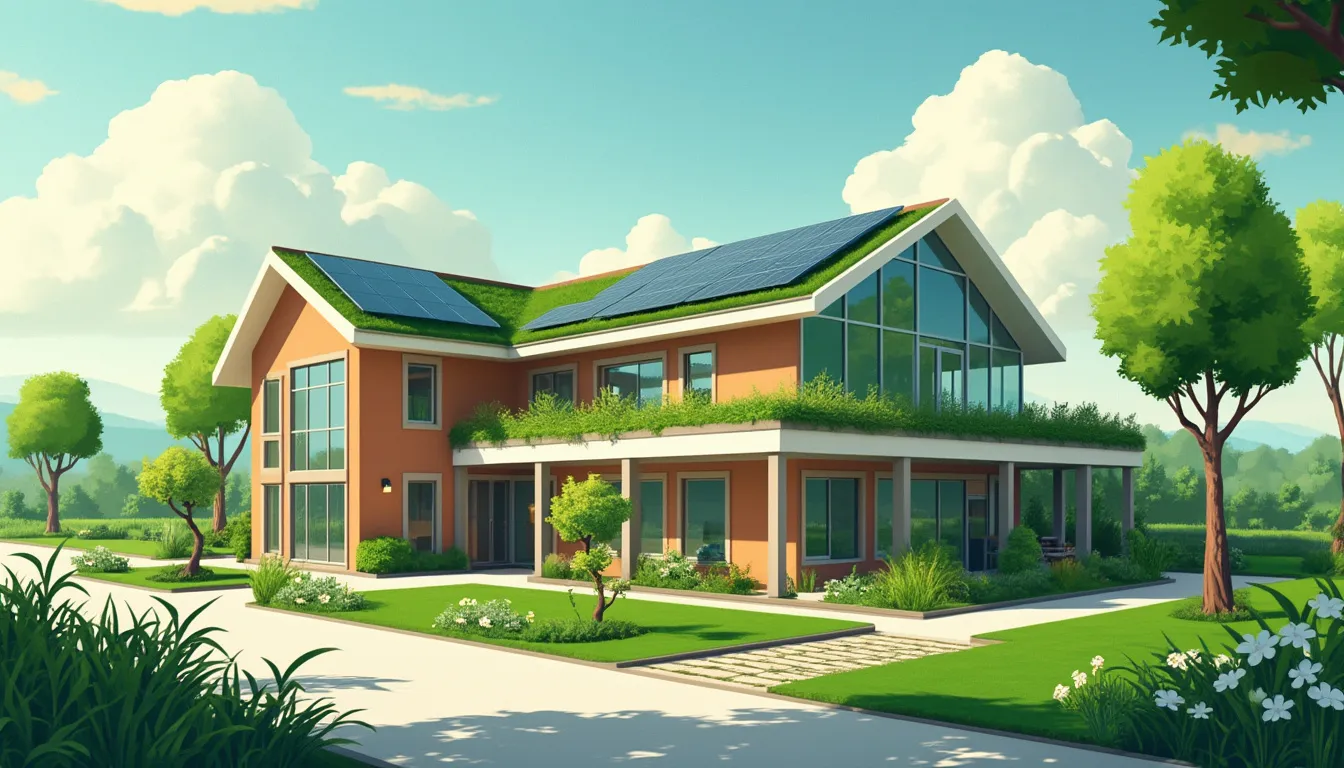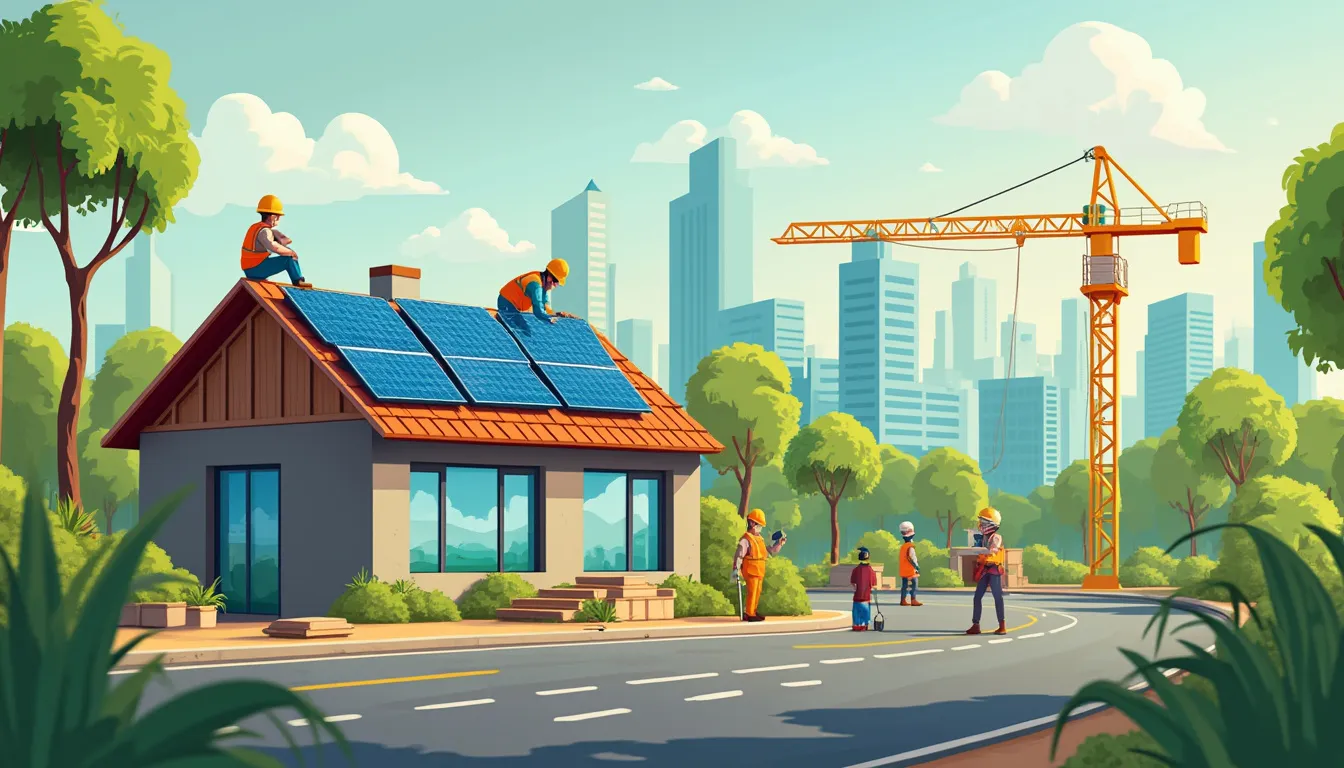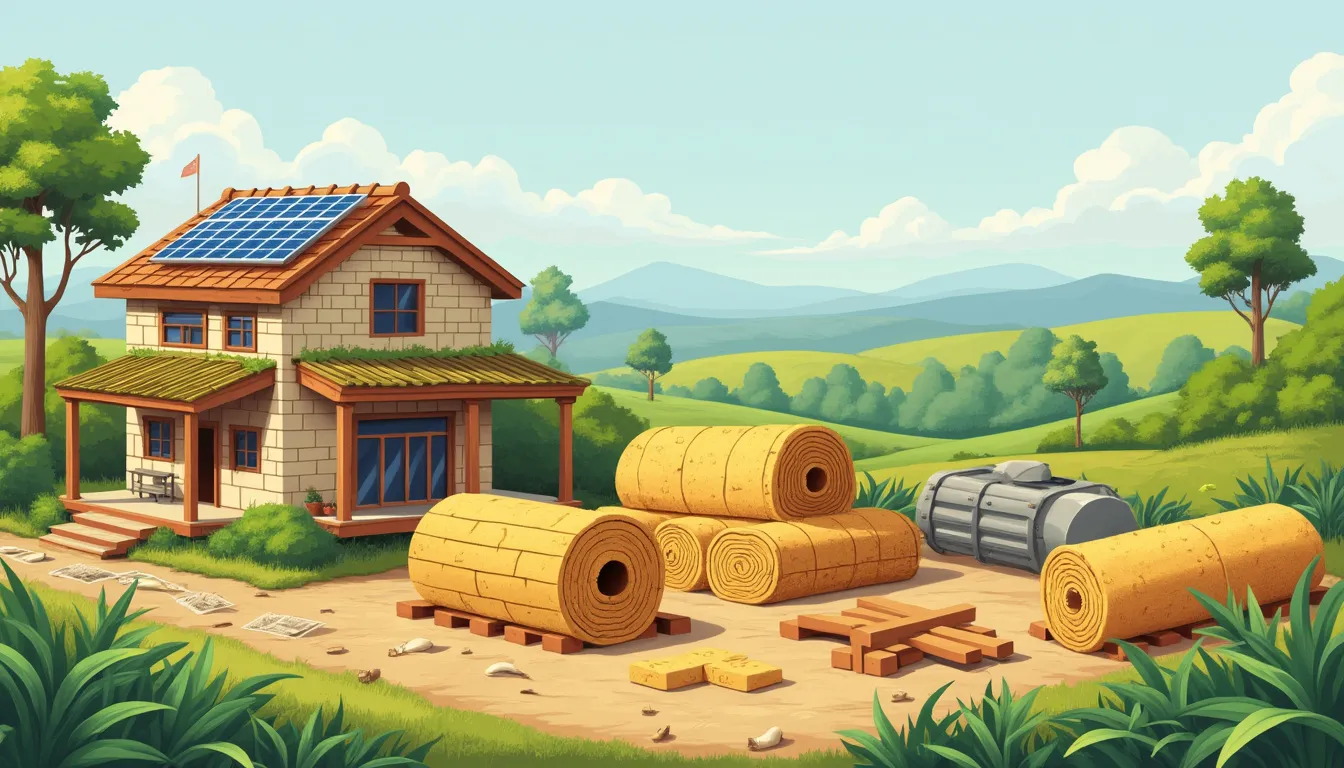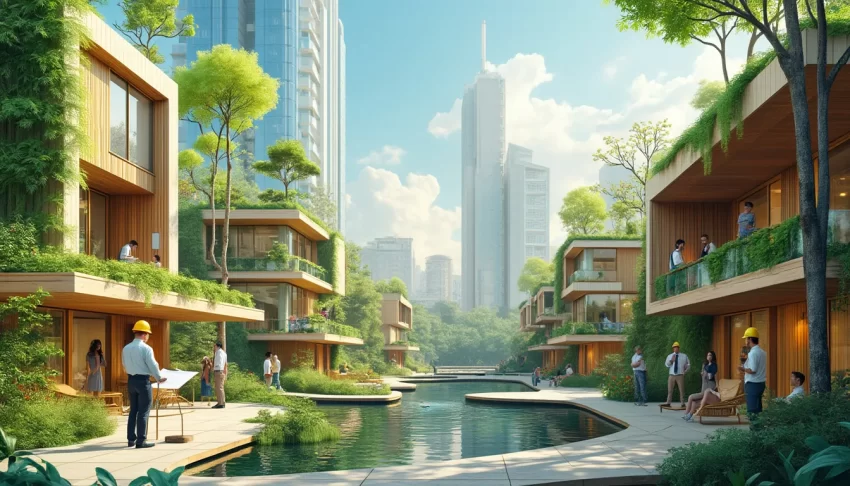In today’s world, where climate change and resource depletion are pressing concerns, the construction industry stands at a pivotal crossroads. The choice to embrace sustainable building materials isn’t just an environmental imperative; it’s a transformative step toward a greener, more resilient future. Sustainable building materials, which are sourced, manufactured, and disposed of in ways that have minimal environmental impact, offer a beacon of hope in the quest for sustainable development. By reducing waste, conserving natural resources, and lowering carbon footprints, these materials play a crucial role in mitigating the environmental impact of construction.
The importance of sustainability in construction cannot be overstated. Traditional building practices often rely heavily on non-renewable resources, leading to significant environmental degradation. Conversely, sustainable building materials, such as recycled steel, bamboo, rammed earth, and reclaimed wood, offer eco-friendly alternatives that not only promote environmental health but also enhance the quality of life for building inhabitants. These materials are designed to create healthier living spaces by improving indoor air quality and reducing exposure to harmful substances.
The benefits of using sustainable building materials are manifold. Environmentally, they help conserve precious natural resources and significantly reduce greenhouse gas emissions. Economically, they offer long-term savings through increased durability and energy efficiency, boosting property values and supporting local economies. On a broader scale, the growing adoption of sustainable building materials fosters innovation and drives the construction industry toward more sustainable practices.
By understanding and implementing sustainable building materials, individuals and businesses alike can make a substantial impact. Whether you’re planning a new construction project, considering a renovation, or simply interested in eco-friendly practices, exploring the benefits and applications of sustainable building materials is a critical step toward ensuring a greener future for generations to come.
Introduction to Sustainable Building Materials
Sustainable building materials are gaining traction in the construction industry as society becomes increasingly aware of our environmental impact. These materials, which range from recycled steel to bamboo, are chosen for their minimal environmental footprint and ability to be replenished or repurposed. The term sustainable building materials refers to a broad category that includes any resources used in construction that are eco-friendly, non-toxic, and contribute to a healthier built environment.
Importance of Sustainability in Construction
The construction industry is one of the largest consumers of raw materials and a significant contributor to global carbon emissions. Traditionally, buildings were erected using materials that, while functional and durable, often took a toll on the environment. These conventional materials require extensive energy for production, lead to significant waste, and deplete natural resources. By contrast, sustainable building materials aim to provide a solution to these issues, promoting a greener future. Adopting sustainable practices in construction is not just a trend; it is a crucial step toward mitigating climate change and preserving our planet for future generations.
Benefits of Using Sustainable Building Materials
The benefits of utilizing sustainable building materials extend far beyond the immediate environmental impact. Let’s delve into some of the key advantages:
- Reduction of Environmental Impact: Sustainable building materials typically require less energy to produce and transport, resulting in a lower carbon footprint. They often incorporate recycled content, reducing the need for virgin resources and minimizing waste.
- Health and Well-being: Many conventional building materials emit volatile organic compounds (VOCs) and other toxins, which can harm indoor air quality and human health. Sustainable options are frequently free of harmful chemicals, contributing to healthier living and working environments.
- Resource Efficiency: Sustainable building materials often make use of renewable resources or have a longer lifespan than traditional materials. For example, bamboo grows much faster than timber and doesn’t require pesticides or fertilizers, making it an eco-friendly alternative.
- Economic Benefits: Although sustainable materials can sometimes have a higher upfront cost, they often result in long-term savings through lower energy bills and reduced maintenance costs. Additionally, buildings constructed with these materials may have higher property values and appeal to environmentally conscious buyers.
Real-life examples illustrate these benefits compellingly. For instance, consider the Bullitt Center in Seattle, dubbed the greenest commercial building in the world. This building features elements like reclaimed wood and solar panels, showcasing how sustainable materials can be integrated into modern designs. The Bullitt Center not only minimizes its environmental impact but also fosters a healthy workspace for its occupants by prioritizing air quality and natural light.
The construction of the Bullitt Center also highlights the importance of sustainability in a larger context. By choosing sustainable building materials and adhering to eco-friendly construction practices, businesses and individuals contribute to a market shift. This shift encourages manufacturers to innovate and develop even more sustainable options, creating a positive feedback loop of environmental stewardship.
As we move toward a more sustainable future, it’s essential to understand the significance and advantages of sustainable building materials. Whether you’re planning a new construction project or looking to renovate an existing space, considering the environmental and health benefits of the materials you choose is a step in the right direction. By opting for sustainable options, you’re not only reducing your environmental footprint but also contributing to a healthier, more resilient world.

Environmental Benefits of Sustainable Building Materials
As the environmental impacts of conventional construction practices become increasingly alarming, the adoption of sustainable building materials has emerged as a key strategy to mitigate these effects. Using sustainable building materials offers a multitude of environmental benefits that extend far beyond their immediate applications. Let’s delve into how these materials can significantly reduce the carbon footprint, conserve natural resources, and enhance indoor environmental quality.
Reduction in Carbon Footprint through Sustainable Building Materials
One of the most significant environmental benefits of using sustainable building materials is their potential to reduce carbon emissions. Traditional construction materials, particularly concrete and steel, are notorious for their high carbon footprints due to the energy-intensive processes involved in their production. For instance, cement production alone is responsible for approximately 8% of global carbon dioxide emissions.
In contrast, sustainable building materials such as bamboo, recycled steel, and rammed earth are manufactured using processes that emit significantly lower levels of greenhouse gases. Bamboo, for example, is a rapidly renewable resource that absorbs carbon dioxide during its growth, effectively acting as a carbon sink. Similarly, recycled steel requires less energy to produce compared to new steel, thereby reducing overall carbon emissions.
Additionally, sustainable building materials often come from local sources, reducing the carbon emissions associated with transportation. By favoring local over imported materials, builders can minimize transportation-related emissions and contribute to a more sustainable construction industry.
Conservation of Natural Resources
Sustainable building materials also play a critical role in conserving natural resources. In conventional construction, the extraction and processing of raw materials can lead to the depletion of limited natural resources and cause significant ecological damage. Deforestation, habitat destruction, and soil erosion are common consequences of unsustainable material sourcing.
Sustainable building materials, on the other hand, prioritize the use of renewable, recycled, and reclaimed resources. Bamboo, for instance, can be harvested in three to five years, making it a highly renewable resource compared to hardwoods that may take decades to mature. Recycled materials, such as reclaimed wood and recycled metal, reduce the demand for virgin resources and divert waste from landfills.
Furthermore, the use of materials with lower embodied energy—such as rammed earth, which involves compacting natural soil—can drastically diminish the amount of energy consumed from extraction to construction. This not only helps conserve non-renewable energy resources but also lessens the overall environmental impact of building projects.
Enhancement of Indoor Environmental Quality
The benefits of sustainable building materials extend indoors, contributing to healthier living and working environments. Conventional building materials and finishes often emit volatile organic compounds (VOCs) and other pollutants, which can significantly degrade indoor air quality and pose health risks to occupants.
Sustainable building materials, however, are typically non-toxic and free from harmful substances. Materials such as low-VOC paints, natural fiber carpets, and formaldehyde-free wood products are designed to improve indoor air quality by minimizing the emission of pollutants. Improved indoor air quality is linked to better health outcomes, increased comfort, and enhanced productivity for building occupants.
Moreover, sustainable materials often offer superior thermal and acoustic properties. Natural materials like wool insulation and clay plasters provide excellent thermal regulation and sound absorption, creating more comfortable and energy-efficient indoor environments. These enhancements contribute to both environmental sustainability and the well-being of individuals who inhabit these spaces.
In conclusion, the environmental benefits of adopting sustainable building materials are manifold. By reducing carbon footprints, conserving natural resources, and enhancing indoor environmental quality, these materials offer a pathway to more sustainable and responsible construction practices. As awareness and technological advancements continue to grow, the shift towards sustainable building materials is not just a trend—it’s an imperative for a greener future.

Economic Advantages of Sustainable Building Materials
Cost-Effectiveness and Long-Term Savings
When considering the financial aspect of sustainable building materials, it’s important to look beyond initial costs. At first glance, some environmentally-friendly options may appear more expensive than traditional materials. However, sustainable building materials often provide substantial savings in the long run. For instance, materials like insulated concrete forms (ICFs) and structural insulated panels (SIPs) offer superior energy efficiency, which can reduce heating and cooling costs significantly over the lifetime of a building. Moreover, the durable nature of these materials means less frequent repairs and replacements, translating to lower maintenance costs.
Many sustainable building materials are designed for longevity and resilience. For example, bamboo is not only a rapidly renewable resource but also highly durable and resistant to pests and natural elements. This durability reduces the need for frequent replacements, further enhancing the cost-effectiveness of using sustainable building materials.
Increased Property Value
Another economic advantage of using sustainable building materials is the potential increase in property value. Homes and commercial properties built with sustainability in mind are increasingly attractive to buyers and renters alike. Features such as energy-efficient windows, solar panels, and eco-friendly insulation are not just appealing but also practical, as they promise reduced utility bills and a lower environmental impact.
Industry studies have shown that green buildings may command a higher market value and can lead to faster sales compared to traditional buildings. According to the World Green Building Council, properties with green certifications such as LEED (Leadership in Energy and Environmental Design) can see a value increase by up to 11%. This enhanced marketability can make sustainable building materials a wise investment not only for the planet but also for your wallet.
Support for Local Economies and Job Creation
Investing in sustainable building materials can also have a positive ripple effect on local economies. Sourcing locally-produced materials reduces transportation costs and emissions, and promotes regional economic growth. For instance, using reclaimed wood from local sources supports local businesses and artisans, reducing the carbon footprint associated with long-distance material transportation.
Moreover, the sustainable building industry is a robust job creator. The production, installation, and maintenance of green building materials and systems require skilled professionals, ranging from architects and engineers to construction workers and tradespeople. This demand fosters job creation in various sectors, boosting local economies and communities. According to a report by the U.S. Green Building Council, the green building sector is expected to contribute millions of jobs and trillions of dollars in global gross domestic product (GDP) by 2024.
Take the example of green roofing systems, which often employ local flora. These systems not only enhance the aesthetic appeal and energy efficiency of buildings but also create jobs in planting, maintaining, and harvesting the vegetation. Similarly, the installation of solar panels is a thriving industry that provides numerous jobs in manufacturing, sales, installation, and maintenance. Supporting these industries through the use of sustainable building materials can drive economic growth at both local and national levels.
Employing sustainable building materials can indeed be a catalyst for economic resilience and prosperity. From reducing long-term operational costs to enhancing property values and bolstering local economies, the financial benefits make a compelling case for integrating these materials into our construction practices. The shift towards sustainability in building not only addresses environmental concerns but also promotes economic vitality, making it a win-win situation for everyone involved.

Popular Types of Sustainable Building Materials
Understanding the variety of sustainable building materials available can significantly impact how we approach construction projects. Not only do these materials offer environmental benefits, but they also provide practical and aesthetic advantages that traditional materials often cannot match. Here, we delve into some of the most popular types of sustainable building materials, their benefits, and their uses.
Recycled Steel
Recycled steel is one of the most prevalent and efficient sustainable building materials. Unlike traditional steel that demands high energy consumption during production, recycled steel utilizes leftover metals, significantly reducing both energy use and environmental impact. Not only does this material excel in strength and durability, but it also reduces the demand for new steel production, which in turn conserves natural resources.
One prominent example demonstrating the effectiveness of recycled steel is in skyscraper construction. For instance, the Empire State Building underwent a major retrofit that incorporated thousands of tons of recycled steel, enhancing its strength while diminishing its carbon footprint. This project showed how recycled steel could be used without compromising structural integrity or aesthetic appeal.
Benefits and Uses:
- Benefits: Eco-friendly, highly durable, requires fewer raw materials.
- Uses: Structural frameworks in residential and commercial buildings, bridges, and even art installations.
Bamboo
Bamboo is rapidly becoming a favorite in sustainable construction due to its outstanding growth rate and versatility. Unlike traditional timber that can take decades to mature, bamboo can grow up to three feet in a single day. It’s an incredibly renewable resource and, when harvested correctly, can regenerate without needing replanting.
Architects and builders are increasingly turning to bamboo for its combination of strength and flexibility. Projects like the Green School in Bali, Indonesia, beautifully illustrate bamboo’s potential. The school used bamboo not only for its structural elements but also for furniture and decorative features, creating a unique and stunning educational environment that harmonizes with nature.
Benefits and Uses:
- Benefits: Highly renewable, robust yet flexible, eco-friendly.
- Uses: Structural beams, flooring, furniture, decorative elements.
Rammed Earth
Rammed earth is one of the oldest building materials, but it has gained renewed interest due to its sustainability. It involves compressing a mixture of earth, sand, and stabilizing agents like lime within a framework to create solid walls. This method requires minimal processing and energy, making it an excellent sustainable choice.
Rammed earth also exhibits superior natural thermal mass, which allows buildings to maintain steady indoor temperatures, reducing the need for artificial heating and cooling. A prime example of this is seen in the Earthship homes in Taos, New Mexico. These homes utilize rammed earth to take advantage of passive solar heating, achieving energy efficiency while providing a unique living experience.
Benefits and Uses:
- Benefits: Low energy consumption, excellent thermal properties, uses locally sourced materials.
- Uses: Residential and commercial walls, foundations, eco-friendly construction projects.
Reclaimed Wood
Reclaimed wood offers a fantastic way to reuse existing timber, minimizing the demand for new wood and reducing deforestation. This type of wood is often salvaged from old buildings, barns, or disused structures and repurposed for new construction. Using reclaimed wood not only preserves precious forests but also offers a unique, rustic aesthetic that new wood cannot replicate.
Moreover, reclaimed wood often holds historical value. For instance, many boutique hotels and high-end restaurants use reclaimed wood to create an ambiance of warmth and character. The Battery Hotel in San Francisco is an excellent example where they enhanced their luxury interiors by incorporating reclaimed wood, adding both sustainability and charm to their space.
Benefits and Uses:
- Benefits: Reduces waste, preserves forests, provides unique aesthetic appeal.
- Uses: Flooring, furniture, wall paneling, and decorative accents.
Future Trends and Innovations in Sustainable Building Materials
The landscape of sustainable building materials is continually evolving, driven by advances in technology and growing awareness of environmental issues. Some of the emerging trends include:
- Bio-based Materials: Innovations like mycelium (mushroom-based material) and algae-based products are paving the way for ultra-sustainable and biodegradable building solutions.
- Smart Materials: These materials can adapt to changing environmental conditions, such as self-healing concrete that can repair its own cracks, reducing the need for repairs and maintenance.
- 3D Printed Materials: 3D printing technology can recycle waste products into building materials, creating custom-designed structures with minimal waste.
These trends illustrate an exciting forward trajectory in the use of sustainable building materials, promising more efficient, eco-friendly, and innovative construction methods. As technology and awareness continue to grow, the future of construction looks greener and more sustainable than ever.
As we navigate the challenges of climate change and resource depletion, the shift toward sustainable building materials stands out as both essential and beneficial. These materials not only present a viable solution to pressing environmental issues, but they also offer significant economic and social advantages. By reducing our carbon footprint, conserving natural resources, and enhancing indoor living conditions, sustainable building materials contribute to a healthier planet and well-being.
From an economic perspective, the adoption of sustainable building materials can lead to substantial cost savings over time. While the initial investment might be higher, the long-term savings in energy and maintenance costs are considerable. Furthermore, buildings constructed with sustainable materials often see an increase in property value, attracting environmentally-conscious investors and tenants alike. These practices also invigorate local economies by creating job opportunities and supporting businesses that produce and supply these innovative materials.
Incorporating materials like recycled steel, bamboo, rammed earth, and reclaimed wood into construction projects shows us the tangible benefits and versatility of sustainable options. Each material presents unique advantages, from the strength of recycled steel to the rapid renewability of bamboo. As technology and research advance, we can anticipate even more innovative solutions emerging, pushing the boundaries of what’s possible in sustainable construction.
Whether you’re a homeowner looking to make greener choices, or a business owner aiming to reduce operational impact, embracing sustainable building materials can make a significant difference. Start by educating yourself about the materials available and choosing those that align best with your specific needs and circumstances. Consider the long-term savings and benefits, not just the initial costs, and weigh these against the broader impact on the environment and community.
In conclusion, the move toward sustainable building materials is more than just a trend—it’s a necessary evolution for a greener future. By making informed decisions and prioritizing sustainability in construction, we can collectively contribute to a healthier, more sustainable world. Together, let’s build structures that not only serve us today but also protect and preserve our planet for generations to come.
Support Us: Check out our recommended products on Amazon.

